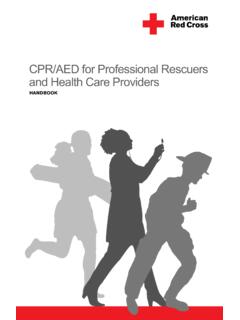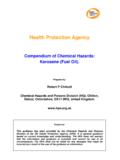Transcription of EMT 2011 Book 1 - phecit.ie
1 CLINICAL PRACTICE GUIDELINES - 3rd Edition Version 2 PractitionerEmergency medical TechnicianPHECC Clinical Practice GuidelinesFirst Edition 2001 Second Edition 2004 Third Edition 2009 Third Edition Version 2 2011 Published by:Pre-Hospital Emergency Care CouncilAbbey Moat House, Abbey Street, Naas, Co Kildare, IrelandPhone: + 353 (0)45 882042 Fax: + 353 (0)45 882089 Email: 978-0-9562261-8-1 Pre-Hospital Emergency Care Council 2011 Any part of this publication may be reproduced for educational purposes and qualityimprovement programmes subject to the inclusion of an acknowledgement of the may not be used for commercial Clinical Practice Guidelines - Emergency medical Technician5 TABLE OF CONTENTS5 PHECC Clinical Practice Guidelines - Emergency medical TechnicianPREFACEFOREWORD.
2 6 ACCEPTED ABBREVIATIONS ..7 ACKNOWLEDGEMENTS ..9 INTRODUCTION ..11 IMPLEMENTATION AND USE OF CLINICAL PRACTICE GUIDELINES ..12 CLINICAL PRACTICE GUIDELINESKEY/CODES EXPLANATION ..16 CLINICAL PRACTICE GUIDELINES - INDEX ..17 SECTION 2 PATIENT ASSESSMENT ..19 SECTION 3 RESPIRATORY EMERGENCIES ..24 SECTION 4 medical EMERGENCIES ..27 SECTION 5 OBSTETRIC EMERGENCIES ..53 SECTION 6 TRAUMA ..55 SECTION 7 PAEDIATRIC EMERGENCIES ..62 SECTION 8 PRE-HOSPITAL EMERGENCY CARE OPERATIONS ..75 Appendix 1 - Medication Formulary ..78 Appendix 2 Medications & Skills Matrix ..91 Appendix 3 Critical Incident Stress Management ..98 Appendix 4 CPG Updates for Emergency medical Technicians.
3 101 Appendix 5 Pre-hospital defibrillation position paper ..112 PHECC Clinical Practice Guidelines - Emergency medical Technician6 FOREWORDIt is my pleasure to write the foreword to this PHECC Clinical handbook comprising 3rd Edition, version 2, Clinical Practice Guidelines (CPGs). There are now 230 CPGs in all, to guide integrated care across the six levels of Responder and Practitioner. My understanding is that it is a world fi rst to have a Cardiac First Responder using guidance from the same integrated set as all levels of Responders and Practitioners up to Advanced Paramedic. We have come a long way since the publication of the fi rst set of guidelines numbering 35 in 2001, and applying to EMTs only at the time.
4 I was appointed Chair in June 2008 to what is essentially the second Council since PHECC was established in 2000. I pay great tribute to the hard work of the previous medical Advisory Group chaired by Mark Doyle, in developing these CPGs with oversight from the Clinical Care Committee chaired by Sean Creamer, and guidance and authority of the fi rst Council chaired by Paul Robinson. The development and publication of CPGs is an important part of PHECC s main functions which are: 1. To ensure training institutions and course content in First Response and Emergency medical Technology refl ect contemporary best practice. 2. To ensure pre-hospital emergency care Responders and Practitioners achieve and maintain competency at the appropriate performance standard.
5 3. To sponsor and promote the implementation of best practice guidelines in pre-hospital emergency care. 4. To source, sponsor and promote relevant research to guide Council in the development of pre-hospital emergency care in Ireland. 5. To recommend other pre-hospital emergency care standards as appropriate. 6. To establish and maintain a register of pre-hospital emergency care practitioners. 7. To recognise those pre-hospital emergency care providers which undertake to implement the clinical practice guidelines. The CPGs, in conjunction with relevant ongoing training and review of practice, are fundamental to achieve best practice in pre-hospital emergency care.
6 I welcome this revised Clinical handbook and look forward to the contribution Responders and Practitioners will make with its Tom Mooney, Chair, Pre-Hospital Emergency Care CouncilPHECC Clinical Practice Guidelines - Emergency medical Technician7 ACCEPTED ABBREVIATIONSA dvanced Paramedic APAdvanced Life Support ALSA irway, breathing & circulation ABCAll terrain vehicle ATVA ltered level of consciousness ALoCAutomated External Defibrillator AEDBag Valve Mask BVMB asic Life Support BLSB lood Glucose BGBlood Pressure BPCarbon dioxide CO2 Cardiopulmonary Resuscitation CPRC ervical spine C-spineChronic obstructive pulmonary disease COPDC linical Practice Guideline CPGD egree oDegrees Centigrade oCDextrose 10% in water D10 WDrop (gutta)
7 GttElectrocardiogram ECGE mergency Department EDEmergency medical Technician EMTE ndotracheal tube ETTF oreign body airway obstruction FBAOF racture #General Practitioner GPGlasgow Coma Scale GCSGram gGreater than >Greater than or equal to Heart rate HRHistory HxImpedance Threshold Device ITDI nhalation InhIntramuscular IMIntranasal INIntraosseous IOIntravenous IVKeep vein open KVOK ilogram KgLess than <SECTION 2 - PATIENT ASSESSMENT Primary Survey AdultPHECC Clinical Practice Guidelines - Emergency medical Technician8 ACCEPTED ABBREVIATIONS (Cont.)Less than or equal to Litre LMaximum MaxMicrogram mcgMilligram mgMillilitre mLMillimole mmolMinute minModified Early Warning Score MEWSM otor vehicle collision MVCM yocardial infarction MINasopharyngeal airway NPAM illiequivalent mEqMillimetres of mercury mmHgNebulised NEBN egative decadic logarithm of the H+ ion concentration pHOrally (per os)
8 POOropharyngeal airway OPAO xygen O2 Paramedic PPeak expiratory flow PEFPer rectum PRPercutaneous coronary intervention PCIP ersonal Protective Equipment PPEP ulseless electrical activity PEAR espiration rate RRReturn of spontaneous circulation ROSCR evised Trauma Score RTSS aturation of arterial oxygen SpO2ST elevation myocardial infarction STEMIS ubcutaneous SCSublingual SLSystolic blood pressure SBPT herefore Total body surface area TBSAV entricular Fibrillation VFVentricular Tachycardia VTWhen necessary (pro re nata) prnPHECC Clinical Practice Guidelines - Emergency medical Technician9 SECTION 2 - PATIENT ASSESSMENT Primary Survey AdultACKNOWLEDGEMENTSThe process of developing CPGs has been long and detailed.
9 The quality of the finished product is due to the painstaking work of many people, who through their expertise and review of the literature, ensured a world-class LEADER & EDITORMr Brian Power, Programme Development Officer, CLINICAL REVIEWDr Geoff King, Director, Pauline Dempsey, Programme Development Officer, Jacqueline Egan, Programme Development Officer, ADVISORY GROUPDr Zelie Gaffney, (Chair) General PractitionerDr David Janes, (Vice Chair) General PractitionerProf Gerard Bury, Professor of General Practitioner University College DublinDr Niamh Collins, Locum Consultant in Emergency Medicine, St James s HospitalProf Stephen Cusack, Consultant in Emergency Medicine, Area medical Advisor, National Ambulance Service SouthMr Mark Doyle, Consultant in Emergency Medicine, Deputy medical Director HSE National Ambulance ServiceMr Conor Egleston, Consultant in Emergency Medicine, Our lady of Lourdes Hospital, DroghedaMr Michael Garry, Paramedic, Chair of Accreditation CommitteeMr Macartan Hughes, Advanced Paramedic, Head of Education & Competency Assurance, HSE National Ambulance ServiceMr Lawrence Kenna.
10 Advanced Paramedic, Education & Competency Assurance Manager, HSE National Ambulance ServiceMr Paul Lambert, Advanced Paramedic, Station Officer Dublin Fire BrigadeMr Declan Lonergan, Advanced Paramedic, Education & Competency Assurance Manager, HSE National Ambulance ServiceMr Paul Meehan, Regional Training Officer, Northern Ireland Ambulance ServiceDr David Menzies, medical Director AP programme NASC/UCDDr David McManus, medical Director, Northern Ireland Ambulance ServiceDr Peter O Connor, Consultant in Emergency Medicine, medical Advisor Dublin Fire BrigadeMr Cathal O Donnell, Consultant in Emergency Medicine, medical Director HSE National Ambulance ServiceMr John O Donnell, Consultant in Emergency Medicine, Area medical Advisor, National Ambulance Service WestMr Frank O Malley, Paramedic, Chair of Clinical Care CommitteeMr Martin O Reilly, Advanced Paramedic, District Officer Dublin Fire BrigadeDr Sean O Rourke, Consultant in Emergency Medicine, Area medical Advisor, National Ambulance Service North LeinsterSECTION 2 - PATIENT ASSESSMENT Primary Survey AdultPHECC Clinical Practice Guidelines - Emergency medical Technician10 SECTION 2 - PATIENT ASSESSMENT Primary Survey AdultACKNOWLEDGEMENTSMs Valerie Small, Nurse Practitioner, St James s Hospital.




